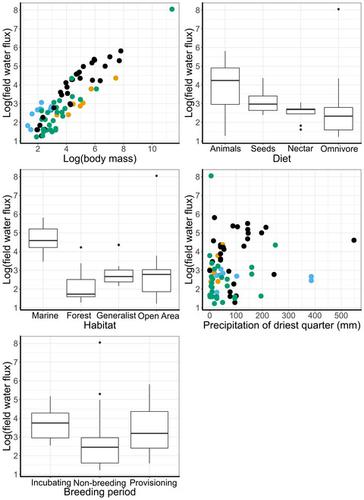当前位置:
X-MOL 学术
›
Funct. Ecol.
›
论文详情
Our official English website, www.x-mol.net, welcomes your
feedback! (Note: you will need to create a separate account there.)
Environmental and ecological correlates of avian field metabolic rate and water flux
Functional Ecology ( IF 4.6 ) Pub Date : 2020-04-01 , DOI: 10.1111/1365-2435.13526 Soorim Song 1 , Steven R. Beissinger 1, 2
Functional Ecology ( IF 4.6 ) Pub Date : 2020-04-01 , DOI: 10.1111/1365-2435.13526 Soorim Song 1 , Steven R. Beissinger 1, 2
Affiliation

|
The field metabolic rate (FMR) of an endothermic animal represents its energy expenditure in a natural environment, or its energy budget, and its field water flux (FWF) reflects the animal's water requirements. We examined FMR of 103 species and FWF of 75 species of adult birds from direct field measurements using the doubly labelled water method, and used the phylogenetic generalized least squares method to conduct a phylogenetically informed, comprehensive analysis of the relationship between FMR, FWF and multiple environmental and biological variables. Field metabolic rate was strongly positively associated with body mass with an allometric exponent of 0.66, and seabirds had lower FMR than terrestrial species. Birds consuming plant matter had lower FMR compared to omnivores, carnivores or nectarivores and low ambient temperature was associated with higher FMR. There was little evidence for phylogenetic covariance in FMR, even though previous studies identified a phylogenetic signal for basal metabolic rate. Life‐history traits, such as fecundity and migration, were also not strongly associated with FMR. Field water flux was strongly positively associated with body mass with an allometric exponent of 0.61, and was strongly related to precipitation but not to temperature. Diet and habitat use had significant effects on FWF, with nectarivores and marine species exhibiting higher values than granivores and forest birds. Thus, FMR and FWF are affected similarly by body size and differently by environmental temperature and precipitation, while the roles of diet, life‐history traits and habitat are more nuanced and generalities remain elusive. A free Plain Language Summary can be found within the Supporting Information of this article.
中文翻译:

鸟类田间代谢率和水通量的环境和生态相关性
吸热动物的田间代谢率 (FMR) 代表其在自然环境中的能量消耗或能量收支,其田间水通量 (FWF) 反映了动物对水的需求。我们使用双标记水法从直接现场测量中检查了 103 种成年鸟类的 FMR 和 75 种成年鸟类的 FWF,并使用系统发育广义最小二乘法对 FMR、FWF 和多个环境和生物变量。野外代谢率与体重呈强正相关,异速生长指数为 0.66,海鸟的 FMR 低于陆生物种。与杂食动物相比,食用植物物质的鸟类具有较低的 FMR,食肉动物或食蜜动物和低环境温度与较高的 FMR 相关。尽管之前的研究确定了基础代谢率的系统发育信号,但几乎没有证据表明 FMR 存在系统发育协变。生活史特征,如生育力和迁移,也与 FMR 没有很强的相关性。田间水通量与体重呈强正相关,异速生长指数为 0.61,与降水密切相关,但与温度无关。饮食和栖息地的使用对 FWF 有显着影响,食蜜动物和海洋物种的价值高于食肉动物和森林鸟类。因此,FMR 和 FWF 受体型的影响相似,受环境温度和降水的影响不同,而饮食的作用,生活史特征和栖息地更加微妙,普遍性仍然难以捉摸。可以在本文的支持信息中找到免费的普通语言摘要。
更新日期:2020-04-01
中文翻译:

鸟类田间代谢率和水通量的环境和生态相关性
吸热动物的田间代谢率 (FMR) 代表其在自然环境中的能量消耗或能量收支,其田间水通量 (FWF) 反映了动物对水的需求。我们使用双标记水法从直接现场测量中检查了 103 种成年鸟类的 FMR 和 75 种成年鸟类的 FWF,并使用系统发育广义最小二乘法对 FMR、FWF 和多个环境和生物变量。野外代谢率与体重呈强正相关,异速生长指数为 0.66,海鸟的 FMR 低于陆生物种。与杂食动物相比,食用植物物质的鸟类具有较低的 FMR,食肉动物或食蜜动物和低环境温度与较高的 FMR 相关。尽管之前的研究确定了基础代谢率的系统发育信号,但几乎没有证据表明 FMR 存在系统发育协变。生活史特征,如生育力和迁移,也与 FMR 没有很强的相关性。田间水通量与体重呈强正相关,异速生长指数为 0.61,与降水密切相关,但与温度无关。饮食和栖息地的使用对 FWF 有显着影响,食蜜动物和海洋物种的价值高于食肉动物和森林鸟类。因此,FMR 和 FWF 受体型的影响相似,受环境温度和降水的影响不同,而饮食的作用,生活史特征和栖息地更加微妙,普遍性仍然难以捉摸。可以在本文的支持信息中找到免费的普通语言摘要。











































 京公网安备 11010802027423号
京公网安备 11010802027423号